
Phragmipedium is a genus of the Orchid family (Orchidaceae) and the only genus comprised in the tribe Phragmipedieae and subtribe Phragmipediinae. The name of the genus is derived from the Greek phragma, which means "division", and pedium, which means "slipper". It is abbreviated 'Phrag' in trade journals.

Coeloglossum is a genus of flowering plants in the orchid family Orchidaceae. It has long been considered to have only one species, Coeloglossum viride, the frog orchid. Some recent classifications regard Coeloglossum as part of the larger genus, Dactylorhiza, so that C. viride becomes Dactylorhiza viridis. Other sources continue to keep Coeloglossum viride separate.

Spiranthes spiralis, commonly known as autumn lady's-tresses, is an orchid that grows in Europe and adjacent North Africa and Asia. It is a small grey-green plant. It forms a rosette of four to five pointed, sessile, ovate leaves about 3 cm (1.2 in) in length. In late summer an unbranched stem of about 10–15 cm (3.9–5.9 in) tall is produced with approximately four sheath-shaped leaves. The white flowers are about 5 mm (0.20 in) long and have a green spot on the lower lip. They are arranged in a helix around the upper half of the stalk. The species is listed in Appendix II of CITES as a species that is not currently threatened with extinction but that may become so. Autumn lady's-tresses are legally protected in Belgium and the Netherlands.

Paphiopedilum fowliei is a species of plant in the family Orchidaceae. It is endemic to Palawan in the Philippines. Its natural habitat is subtropical or tropical moist lowland forests. It is threatened by habitat loss.
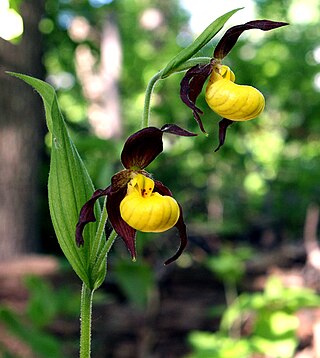
Cypripedium parviflorum, commonly known as yellow lady's slipper or moccasin flower, is a lady's slipper orchid native to North America. It is widespread, ranging from Alaska south to Arizona and Georgia. It grows in fens, wetlands, shorelines, and damp woodlands.
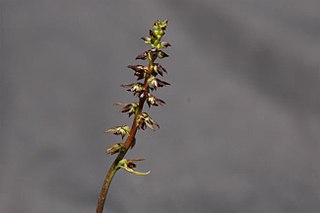
Genoplesium plumosum, commonly known as the Tallong midge-orchid or plumed midge-orchid, is a species of orchid endemic to New South Wales. It is a small orchid only known from a few sites near the towns of Tallong and Wingello on the Southern Tablelands and is only relatively easy to find for about a month, when it flowers. It has been classified as "Endangered" under the EPBC Act.

Paphiopedilum insigne is an Asian species of slipper orchid and the type species of the genus Paphiopedilum. Its name is derived from the Latin insigne, meaning 'badge of honor' due to the magnificent flower. In the 19th century it was very popular among European and American orchid growers, causing it to become very rare in the wild due to over collecting. There are many varieties of it and hybrids with it.

Paphiopedilum sanderianum is a rare species of orchid endemic to northwestern Borneo. First discovered in 1885 by F. Sander's collector, J. Foerstermann, the orchid became renowned for the remarkable length of its petals, which can measure over 1 meter long. Although P. sanderianum has been used as a parent in a number of crosses, none of the resulting hybrids have so far matched the extraordinary lengths of this species' petals. However, soon after the turn of the 20th century, this rare orchid was lost to cultivation and thought to be extinct in the wild, until its rediscovery in 1978 by Ivan Nielson. The wild population of Paphiopedilum sanderianum grows protected in Gunung Mulu National Park.
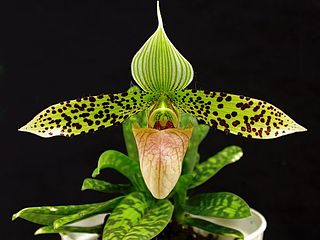
Paphiopedilum sukhakulii is a species of plant in the family Orchidaceae.

Dendrobium linguiforme, commonly known as the thumbnail orchid, tick orchid or tongue orchid, is a plant in the orchid family Orchidaceae and is endemic to eastern Australia. It grows on trees or on rocks, with wiry, prostrate stems, prostrate, fleshy leaves and spikes of up to twenty white to cream-coloured flowers in early spring.

Roscoea schneideriana is a perennial herbaceous plant found in China, in Tibet, Sichuan and Yunnan. Most members of the ginger family (Zingiberaceae), to which it belongs, are tropical, but R. schneideriana, like other species of Roscoea, grows in much colder mountainous regions.
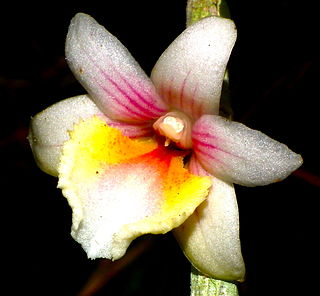
Dendrobium boosii, or Ronny Boos' dendrobium, is a species of plant in the family Orchidaceae endemic to the Philippines.
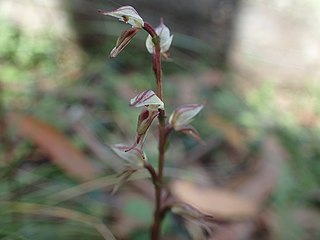
Acianthus apprimus, commonly known as early mosquito orchid, is a species of flowering plant in the orchid family Orchidaceae and is endemic to New South Wales in Australia. It is a terrestrial herb with a single, heart-shaped leaf and between two and nine translucent pinkish flowers with reddish markings and is found in disjunct populations around the state.

Paphiopedilum parishii is a species of orchid found in northern and western Thailand, Laos, Myanmar, Yunnan and Assam, in montane forests at 1200–2200 m above sea level. It is named after Charles Samuel Pollock Parish, an English botanist and avid plant collector who had a particular interest in the flora of Myanmar.
Pelatantheria rivesii is a species of epiphytic or lithophytic orchid occurring in China, Laos and Vietnam. This species closely resembles Pelatantheria insectifera bothin its vegetative and generative morphology. The commonly branched stems may reach lengths of 1 m and diameters of 7 mm. Few flowers are produced during October on short racemes, which do not exceed the length of the leaves. The flowers are small and fleshy and the sepals and petals are pale yellow and bear striped. The labellum is pink.
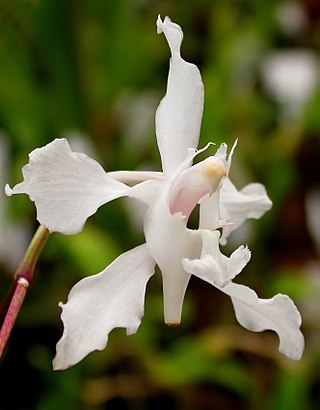
Papilionanthe vandarum is a species of epiphytic orchid native to India, China, Myanmar, and Nepal. It is closely related to Papilionanthe biswasiana.

Papilionanthe uniflora is a species of epiphytic orchid native to India, Myanmar, Bhutan and Nepal.
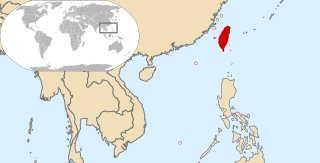
× Papilisia taiwaniana is an artificial hybrid of the orchid species Papilionanthe teres and Luisia megasepala. It arose after the introduction of Papilionanthe teres to Taiwan, where it interbred with the Taiwanese endemic Luisia megasepala. It was formerly included in Papilionanthe.

Phalaenopsis hygrochila, also known as 湿唇兰 in Chinese, is a species of epiphytic orchid native to Assam, Borneo, China South-Central, China Southeast, East Himalaya, Laos, Malaya, Myanmar, Bangladesh, Nepal, Sumatera, Thailand, Vietnam and West Himalaya.

Paphiopedilum subgenus Megastaminodium is a subgenus of the orchid genus Paphiopedilum. It was erected to accommodate the single species Paphiopedilum canhii due to its distinct characteristics that made it unfit for the other subgenera. Its placement has since been backed by cytological, molecular and micromorphological evidence.


















